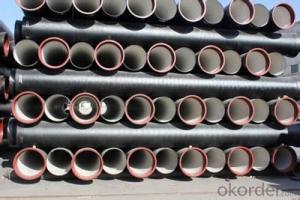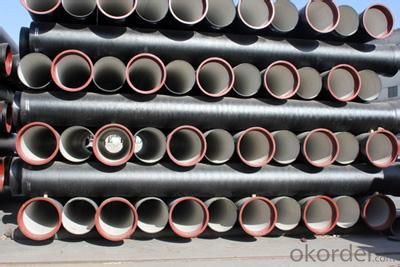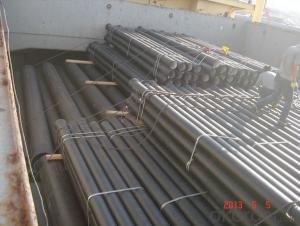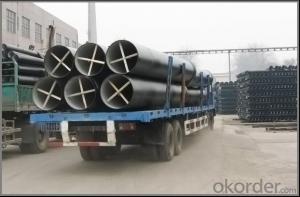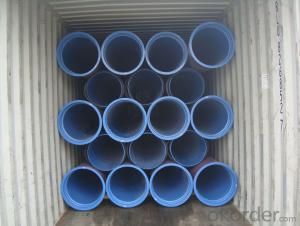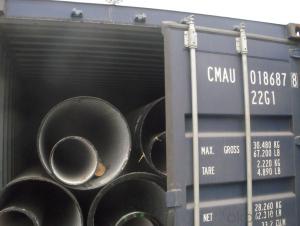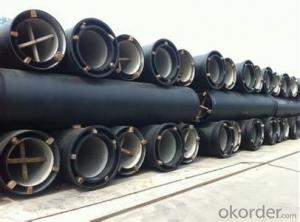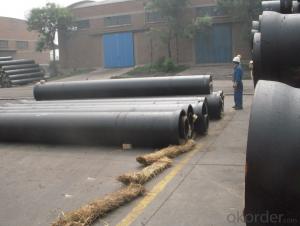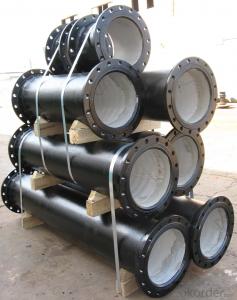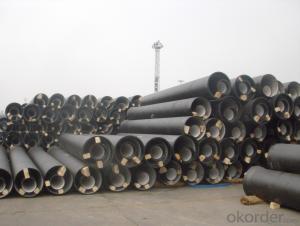DUCTILE IRON PIPES AND PIPE FITTINGS K8 CLASS DN700
- Loading Port:
- Tianjin
- Payment Terms:
- TT OR LC
- Min Order Qty:
- 22 pc
- Supply Capability:
- 3000 pc/month
OKorder Service Pledge
OKorder Financial Service
You Might Also Like
Material : Ductile Cast Iron
Size Range : DN 80mm to DN 2000mm
Unit Effective Length : 6m or 5.7m
Manufacture Standard: ISO 2531:1998/ EN 545:2006/EN 598:2007
Annual capacity : 200,000 tons
Coating Exterior: Zinc 130g/m2 according to ISO 8179-1 and bitumen coating 70 microns.
Cement Interior: Portland Cement/ High Alumina Cement/ Sulphate Resisting Cement Lining according to ISO 4179
Special requirements on external coating and internal lining can be applied
We also provide accessories such as SBR/EPDM rubber gaskets, lubricant paste, pipe caps, PE sleeves, etc.
Additional Parts:
Each pipe is strictly inspected according to related standard to ensure permanently high performance.
Easy Installation at site and service free for life
Long Service Lifespan
Quotation will arrive you within 24hours once we get your inquiry.
We guarantee offering you a competitive price.
A copy of original inspection reports of pipes will be offered after shipment.
Photos of loading process will be sent to the customer after shipment effect.
We will follow-up the delivery progress after shipment effect and update to the customer on weekly basis.
- Q: Ductile iron pipe in the direction of it?
- The use of cast iron by adding more than 18 nodularizer, after centrifugal ductile cast iron machine high speed centrifugal cast pipe, called "ductile" (Ductile Cast Iron Pipes), referred to as ball pipe, ductile iron pipe and ductile iron pipe etc..
- Q: How are ductile iron pipes protected against abrasion or wear?
- Ductile iron pipes are protected against abrasion or wear through various methods and protective coatings. One of the most common methods is the application of cement mortar lining on the inner surface of the pipe. The cement mortar creates a smooth and hard layer that resists the effects of abrasion and wear caused by the flowing water or other materials passing through the pipe. Additionally, ductile iron pipes can be externally protected by applying a bituminous or epoxy coating. These coatings provide a barrier against external factors such as soil or chemicals that may cause wear or corrosion. The coating acts as a protective layer, preventing direct contact between the iron pipe and the surrounding environment. Moreover, for areas with severe abrasion or wear conditions, special linings or coatings can be applied. Polyethylene encasement or polyurethane lining can be used to provide enhanced protection against abrasion, particularly in areas where the pipe is exposed to high levels of turbulence or abrasive materials. In some cases, ductile iron pipes can also be reinforced with additional materials such as fiberglass or steel wire to increase their resistance to abrasion or wear. These reinforcements provide an extra layer of protection, strengthening the pipe and reducing the likelihood of damage. Overall, ductile iron pipes are designed with a combination of protective measures to ensure their durability and resistance to abrasion or wear. These measures include cement mortar linings, protective coatings, special linings or coatings for severe conditions, and reinforcements. These protective methods help extend the lifespan of the pipes and maintain their functionality even in harsh environments.
- Q: What are the different types of joints used with ductile iron pipe?
- The different types of joints commonly used with ductile iron pipe include push-on joints, mechanical joints, restrained joints, flanged joints, and welded joints. Each type of joint offers different benefits and is used depending on the specific requirements of the installation.
- Q: Is nodular cast iron pipe filled with Yau Ma Tei?
- In many areas of our country, ductile iron pipe in the middle and small diameter to tube connected with the tube, the bearing type or flange interface method; ductile iron, angle limit must be allowed better seismic performance and sealing performance.
- Q: Can ductile iron pipe be used for pump stations?
- Certainly, pump stations can utilize ductile iron pipe. Ductile iron pipe is extensively employed in underground water and wastewater systems, including pump stations. It provides numerous benefits, including remarkable strength, durability, and resistance to corrosion, thus ensuring its appropriateness for such purposes. Moreover, ductile iron pipe seamlessly harmonizes with various pump types and is renowned for its extended lifespan, rendering it an optimal selection for pump station projects.
- Q: The design uses water supply ductile iron pipe, PE corrosion protection pipe, HDPE pipe, please ask that good? What's the price of the two?
- PE pipe is hot melt connection (with thick wall smooth type, don't use the wavy), has the advantages of convenient connection, not affected by terrain, but should pay attention to cold and rain when try not to do, otherwise easily lead to cracks or Water Leakage interface touch interface. The disadvantage is not pressure, heavy machinery on the flat, but the problem is not, as long as the water does not leak, do not need to redo. Also, PE price volatility is relatively large, the size of the price difference is relatively large, a few more runs to ask the price.
- Q: Are there any special coatings or linings available for ductile iron pipe?
- Yes, there are special coatings and linings available for ductile iron pipe. These coatings and linings are applied to the internal and/or external surfaces of the pipe to provide protection against corrosion and extend the lifespan of the pipe. Some common coatings and linings used for ductile iron pipe include cement mortar lining, polyethylene encasement, epoxy coating, and polyurethane lining. These coatings and linings are designed to prevent the pipe from corroding when in contact with various substances such as water, chemicals, and soil. The specific coating or lining used depends on the application and the environment in which the pipe will be installed.
- Q: Can ductile iron pipes be used for irrigation of golf courses?
- Yes, ductile iron pipes can be used for irrigation of golf courses.
- Q: What is the difference between cast iron pipe and seamless steel pipe and galvanized steel pipe?
- Cast iron pipe: cast pipe made of cast iron. Cast iron pipes are used for water supply, drainage and gas transmission lines. They include cast iron pipes and pipe fittings. Labor intensity is small. According to the casting method, it is divided into continuous cast iron pipe and centrifugal cast iron pipe, in which the centrifugal cast iron pipe is divided into sand mould and metal type two kinds. Divided into gray cast iron pipe and nodular cast iron pipe according to different material. According to the interface form, it is divided into flexible interface, flange interface, self anchored interface, rigid interface and so on. Among them, the flexible iron pipes rubber sealing ring; flange interface cast iron pipe flange fixed in the rubber pad, the flange gasket sealing; rigid interface cast iron pipe socket is large, straight pipe is inserted, sealed with cement, this technology has been basically eliminated.
- Q: How do ductile iron pipes handle pipe deflection?
- Ductile iron pipes possess exceptional strength and flexibility, enabling them to effectively handle pipe deflection. Pipe deflection, referring to the bending or curving of a pipe from its original straight alignment, is easily managed by ductile iron pipes. When external forces such as soil movement or heavy loads are applied, ductile iron pipes possess the ability to flex and adapt without fracturing or breaking. This remarkable capability is a result of their unique composition, which includes nodular graphite inclusions that provide excellent ductility. The flexibility of ductile iron pipes allows for the absorption and even distribution of stress along the pipe wall, preventing concentrated points of strain that could lead to failure. This characteristic enables the pipes to accommodate ground movement, settlement, and other external factors that may result in deflection. Moreover, ductile iron pipes possess a high modulus of elasticity, ensuring they can endure significant deformation before reaching their ultimate limit. This property ensures the pipes maintain their structural integrity even when subjected to substantial deflection. Additionally, the joint system utilized in ductile iron pipe installations contributes to their ability to handle pipe deflection. The restrained joint design guarantees a tight and secure connection between pipe sections, reducing the potential for joint separation or leakage caused by deflection-induced stress. All in all, ductile iron pipes exhibit excellent resistance to pipe deflection. Their flexibility, high modulus of elasticity, and dependable joint system make them the preferred choice for a wide range of applications, including water distribution, wastewater management, and sewer systems.
Send your message to us
DUCTILE IRON PIPES AND PIPE FITTINGS K8 CLASS DN700
- Loading Port:
- Tianjin
- Payment Terms:
- TT OR LC
- Min Order Qty:
- 22 pc
- Supply Capability:
- 3000 pc/month
OKorder Service Pledge
OKorder Financial Service
Similar products
Hot products
Hot Searches
Related keywords
